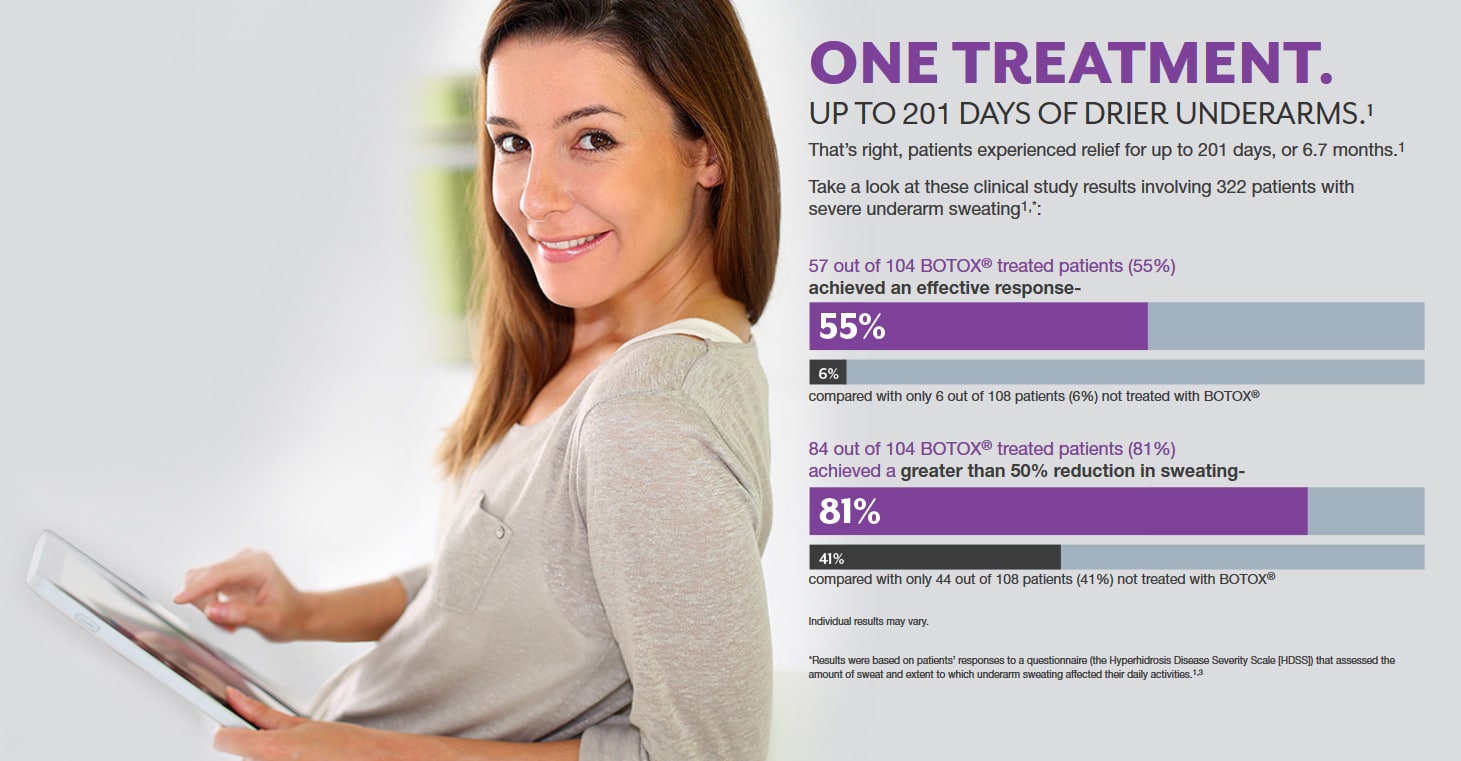Do you sweat “too much”?
Discover lasting relief with Botox® – Up to 6 months of drier underarms with 1 treatment!
Botox® (onabotulinumtoxinA) is injected into the skin to treat symptoms of severe underarm sweating (severe primary axillary hyperhidrosis) when medicines used on the skin (topical) do not work well enough in people 18 years and older. In a clinical study, the duration of response in patients receiving Botox® treatment was 201 days, or 6.7 months. Individual results may vary.
If you do any of the following to cope with sweating, book a Free Consultation Today:
- Change your clothes frequently
- Put absorbent materials under clothing
- Avoid certain fabrics or clothing styles
- Seek medical attention and treatment
Want to know if Botox is a good option for your underarm sweating? You can take this quiz if you'd like to find out if it’s time to talk to your Nurse Injector about severe underarm sweating.

Call 781-821-0707 for an appointment!
Frequently asked questions about BOTOX® for Underarm Sweating
In a clinical study, patients had drier underarms for up to 201 days, or 6.7 months.1 Individual results may vary.
BOTOX® temporarily blocks the chemical signals from the nerves that stimulate the sweat glands. When the sweat glands don’t receive chemical signals, severe underarm sweating is reduced. Sweat will continue to be produced elsewhere.
BOTOX® is proven to work. A clinical study found that: 57 out of 104 patients treated with BOTOX® (55%) achieved an effective response, compared with only 6 out of 108 not treated with BOTOX® (6%)1 84 out of 104 patients treated with BOTOX® (81%) achieved a greater than 50% reduction in sweating, compared to only 44 out of 108 patients not treated with BOTOX® (41%)1 Individual results may vary.
BOTOX® is proven to work. A clinical study found that: 57 out of 104 patients treated with BOTOX® (55%) achieved an effective response, compared with only 6 out of 108 not treated with BOTOX® (6%)1 84 out of 104 patients treated with BOTOX® (81%) achieved a greater than 50% reduction in sweating, compared to only 44 out of 108 patients not treated with BOTOX® (41%)1 Individual results may vary.
BOTOX® can cause serious side effects, such as problems swallowing, speaking or breathing, as well as loss of strength and all-over muscle weakness, and loss of bladder control. Other side effects of BOTOX® include: dry mouth, discomfort or pain at the injection site, tiredness, headache, neck pain, and eye problems: double vision, blurred vision, decreased eyesight, drooping eyelids, swelling of your eyelids, and dry eyes. Symptoms of an allergic reaction to BOTOX® may include: itching, rash, red itchy welts, wheezing, asthma symptoms, or dizziness or feeling faint. Tell your doctor or get medical help right away if you are wheezing or have asthma symptoms, or if you become dizzy or faint. Tell your doctor if you have any side effect that bothers you or that does not go away. These are not all the possible side effects of BOTOX®. For further information, please refer to the Medication Guide and make sure to talk to your Nurse Injector.
BOTOX® can cause serious side effects, such as problems swallowing, speaking or breathing, as well as loss of strength and all-over muscle weakness, and loss of bladder control. Other side effects of BOTOX® include: dry mouth, discomfort or pain at the injection site, tiredness, headache, neck pain, and eye problems: double vision, blurred vision, decreased eyesight, drooping eyelids, swelling of your eyelids, and dry eyes. Symptoms of an allergic reaction to BOTOX® may include: itching, rash, red itchy welts, wheezing, asthma symptoms, or dizziness or feeling faint. Tell your doctor or get medical help right away if you are wheezing or have asthma symptoms, or if you become dizzy or faint. Tell your doctor if you have any side effect that bothers you or that does not go away. These are not all the possible side effects of BOTOX®. For further information, please refer to the Medication Guide and make sure to talk to your Nurse Injector.
Talk to your Nurse Injector at any time about your condition and BOTOX® treatment. It’s possible your underarm sweating can be managed by a topical agent, such as an antiperspirant or deodorant containing an aluminum-based compound. If that doesn’t work, ask your Nurse Injector if BOTOX® treatment may be right for you.
To make the right treatment decision, discuss the following with your Nurse Injector:
- Your Nurse Injector’s experience with BOTOX® treatment
Effectiveness of BOTOX® treatment and important safety information about BOTOX® injections - You should tell your Nurse Injector about all your medical conditions, including if you have:
- A disease that affects your muscles and nerves (such as amyotrophic lateral sclerosis [ALS or Lou Gehrig’s disease], myasthenia gravis, or Lambert-Eaton syndrome).
- Allergies to any botulinum toxin product
- Had any side effect from any botulinum toxin product in the past
- A breathing problem, such as asthma or emphysema
- Swallowing problems
- Bleeding problems
- Plans to have surgery
- Had surgery on your face
- Weakness of your forehead muscles, such as trouble raising your eyebrows - Drooping eyelids
- Any other change in the way your face normally looks
- Are pregnant or plan to become pregnant. It is not known if BOTOX® can harm your unborn baby
- Are breast-feeding or plan to breastfeed. It is not known if BOTOX® passes into breast milk - Tell your Nurse Injector about all the medicines you take, including prescription and nonprescription medicines, vitamins, and herbal products. For further information, please refer to the Medication Guide and make sure you talk to your dermatologist.
Once treatment becomes effective, you will have a significant reduction in sweating. Individual results may vary. There is a possibility that some sweat glands may be missed, and you may continue to experience some sweating from the untreated areas. If you do not see a significant reduction in sweating, you should contact your Nurse Injector and request a follow-up consultation.
References:
1. BOTOX® Prescribing Information, January 2016.
2. U.S. National Library of Medicine. National Institutes of Health (NIH). MedlinePlus website. https://www.nlm.nih.gov/medlineplus/ency/article/007259.htm. Updated May 21, 2013. Accessed October 22, 2014.
3. U.S. National Library of Medicine. National Institutes of Health (NIH). MedlinePlus website. https://www.nlm.nih.gov/medlineplus/ency/article/003218.htm. Updated April 24, 2013. Accessed October 1, 2014.
4. Solish N, Bertucci V, Dansereau A, et al. A comprehensive approach to the recognition, diagnosis, and severity-based treatment of focal hyperhidrosis: recommendations of the Canadian Hyperhidrosis Advisory Committee. Dermatol Surg. 2007;33(8):908-923.
5. American Academy of Dermatology (AAD). Hyperhidrosis: Diagnosis and treatment. AAD website. https://www.aad.org/dermatology-a-to-z/diseases-and-treatments/e—h/hyperhidrosis/hyperhidrosis-diagnosis-and-treatment. Accessed October 23, 2014.
6. International Hyperhidrosis Society. OnabotulinumtoxinA Injections (BOTOX®). International Hyperhidrosis Society website. https://www.sweathelp.org/en/hyperhidrosis-treatments/botox.html. Updated 2014. Accessed October 23, 2014.


